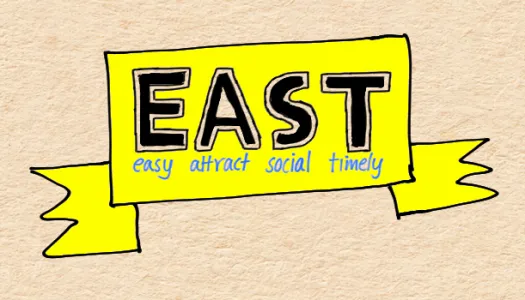
If we want to change our behaviour or influence the behaviour of a group of people around us for the better, what should we do?
In Inside The Nudge Unit, David Halpern describes how the Behavioural Insights Team in the UK government showed that designing policy using behavioural insights dramatically improves results and outcomes.
If we're trying to do something - for example encourage more people to use public transport or corporations to invest in energy efficiency - we can use a simple framework developed by the Nudge unit to design a programme.
The framework can be remembered with a mnemonic - EAST - which stands for easy, attract, social and timely.
We need to start by making things Easy.
Just as water flows downhill, people are more likely to do something if it's simple or the default option.
Anything that adds friction reduces performance - so we can remove friction to make things easier, or add it to make things harder.
For example, supermarkets now keep healthy snacks closer to checkout and sweets further away so that buyers find it easier to choose a healthy option rather than an unhealthy one.
Asking people to turn off the lights or the tap when they leave requires an action from them.
Making it the default through a sensor and switch or taps that open for a preset amount of time makes this easier.
Then we need to get their attention - attract them.
We can do this if we personalise information, make key points obvious, use trusted, authoritative or well-known people to publicise information and create incentives for them to act.
The key thing is getting people to have an emotional connection with the idea.
We are also more likely to do things if we see other people doing them - we are social creatures.
We look around us for guidance and confirmation that what we are doing is the right thing to do.
In many organisations, recycling is now the norm with segregated bins for different kinds of waste.
We need to make use of networks to reach out and use social recognition - awards, committments, promises - as ways to engage and enthuse people.
For example, people are much more likely to recycle when they see other people also doing it. Conversely, if they see others littering, they are more likely to do that too.
Finally, interventions work best when they are timely.
For example, the best time to work with organisations to improve energy efficiency is to engage with them at the point they are making new purchases.
That is when they can compare the purchase costs of different pieces of kit to the lifetime costs of owning and operating the kit.
If they can see that they save money over the long term at that point, then the are more likely to go for the better, more expensive option, rather than going for a cheap thing now that is more expensive and wasteful over the long term.
When we're planning a change, whether at an individual or organisational level, we need to look at our plans and see how things might work out.
We are much more likely to be successful if we can tick off the four elements of the EAST framework.
Read more posts at Karthik-Suresh.com or connect with me on LinkedIn.